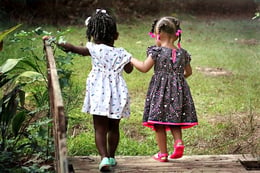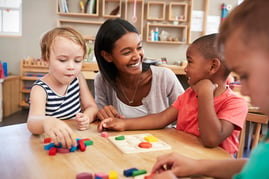[ad_1]
Socialization is an important skill for all children to learn and develop. Research suggests that by supporting a child’s socialization, children are more likely to develop self-confidence, problem solving skills, and key language skills, all of which are vital skills that they will use throughout their lives1. Moreover, socialization can increase the likelihood of many positive outcomes for children, such as becoming more active participants in their communities, increased happiness, and friendship development2. However, many children with autism have difficulty interacting with others, thereby impeding their socialization skill development. Social skills such as initiating conversations with others, playing a game with their peers, sharing, or taking turns can be challenging and overwhelming for children with autism.
Recognizing this challenge for students with autism, ARIS (a new comprehensive early autism education curriculum) has developed an entire set of lessons, based on research, that focus on socialization and group play. The ARIS lessons provide ways to promote socialization for students with autism, specifically in the following ways: sharing, taking turns, joint attention, participating in group songs with action, playing games with adults and/or peers, recess, playing games with multiple peers, parallel play, and narrated play.
As an important foundation skill for social skills and cooperative play, sharing can be very difficult for young children with autism. However, its benefits are great: sharing can greatly improve a child’s ability to interact well with their peers.
The ARIS lessons scaffold the sharing process. First, the child can play with a toy or engage in an activity that they enjoy and are able to do independently. Then, the teacher can approach the child and play the same activity or with the same toy beside them, mimicking the child’s actions while smiling and having fun with the activity. The teacher can then exchange objects with the child, giving the instruction, “Let’s share” and continue to play while narrating. This process would continue until the child is able to independently share by exchanging his or her toys.
While sharing introduces the child to the idea of giving up an activity to a playmate in exchange for another preferred item or activity, taking turns requires the student to give up their turn and wait while someone else takes a turn. Similarly, taking turns is a vital skill for students with autism to learn, as it is a foundational skill for more advanced social and play skills.
While playing a turn-taking activity like a board game, for example, adults are encouraged to give clear instructions and narrate by saying “Your turn” and “My turn.” Throughout, adults can reinforce students for good turn-taking. This process can continue until the game or activity is completed and once finished the adult should be sure to give extra reinforcement to the student for completion.
Joint attention, otherwise known as shared attention, refers to the shared focus of two individuals on an object and occurs when one individual alerts another to an object by means of eye-gazing, pointing, or other verbal or non-verbal cues.
 Joint attention requires the adult to first get the child’s attention and then create a circumstance in which joint attention would be a typical, age-appropriate response. The adult may give a verbal or physical instruction by stating, “Look what I have” or pointing to an object in order to engage the child in joint attention. The adult can use either verbal or physical instruction depending on which the student responds to best. Throughout this process, the adult can wait for the student to reference the item and look back at them, and then, the adult can reinforce the student.
Joint attention requires the adult to first get the child’s attention and then create a circumstance in which joint attention would be a typical, age-appropriate response. The adult may give a verbal or physical instruction by stating, “Look what I have” or pointing to an object in order to engage the child in joint attention. The adult can use either verbal or physical instruction depending on which the student responds to best. Throughout this process, the adult can wait for the student to reference the item and look back at them, and then, the adult can reinforce the student.
- Participating in Group Songs with Action
Another way to increase a child’s socialization skills is by allowing them to participate in group songs with actions. This is a common early-education classroom expectation for all children, and facilitates learning through fun and engaging songs, as well as the shared social experience of participating in circle time activities with peers.
In order to do this, the adult can begin by giving an instruction asking the student to sing a song with actions. They may choose to say something like, “Let’s sing,” “Time to sing,” or “We’re going to sing,” depending on which instruction the child responds to best. The adult can then model singing the song and using the actions, prompting the child to sing along and copy the adult’s actions. Finally, the adult can reinforce the child for singing and acting out the song with them.
- Play a game with adult and/or peers
Moreover, playing a game with an adult or peers can foster healthy social interactions while building learning skills. Not only is playing a game a way to support a child’s enthusiasm for mastering new skills, but it also satisfies their competitive urges. Game play encourages children to show good sportsmanship, be patient, and allows them to get a sense of satisfaction for helping others. (Great games to play can be found in our article: 12 Popular Games Adapted for Children with Autism.)
Similar to how the adult begins by giving an instruction to a child for participating in a group song with actions, the adult can give instructions that ask the child to engage in playing a game. These could be phrases such as:
- “Let’s play a game,”
- “Time to play a game,”
- “We’re going to play a game,” or
- “I want to play ____. Will you play with me?”
While the adult engages in playing a game with the child, he or she will prompt as necessarily and ensure the child is using their turn taking skills, while reinforcing along the way.
Similarly, when wanting to support the child with playing game with other peers, the adult may give instructions by stating:
- “Time to play a game with [Julie],”
- “It’s game time,”
- “Why don’t you all play a game together?,” or
- “[Adam] wants to play ____ with you.”
Peer-to-peer play time can be a great opportunity to utilize peer scaffolding, or the process where one peer models a skill or behavior for another. This is a prime time to utilize any intentional pairings that might help a child improve in their skills.
What better place to play games than at recess? By providing time at recess, adults are supporting a child’s social skill development. During recess time, the adult gives clear instructions that it is time for recess, helps them choose an activity during recess, and encourages the child to try various activities. Additionally, the adult would encourage the child to interact with his or her peers and reinforce them throughout.
 Parallel Play provides an opportunity for children to learn how to share space with others while playing independently. During parallel play, the adult ensures they have the child’s attention before giving instructions to play. The adult begins to play with a toy or item, waiting for the child to mimic them and reinforcing as appropriate. Once a child masters this first phase, they will do the same thing, but when sitting next to a peer. The adult will watch to see if the child plays with their toys in a similar way that the peer does and will reinforce as appropriate.
Parallel Play provides an opportunity for children to learn how to share space with others while playing independently. During parallel play, the adult ensures they have the child’s attention before giving instructions to play. The adult begins to play with a toy or item, waiting for the child to mimic them and reinforcing as appropriate. Once a child masters this first phase, they will do the same thing, but when sitting next to a peer. The adult will watch to see if the child plays with their toys in a similar way that the peer does and will reinforce as appropriate.
On the other hand, narrated play connects the student with physical materials while scaffolding meaning and context for the world around them. Narrated play helps build language skills and peer interaction.
During the first phase of narrated play, the adult describes the child’s actions as they are engaging with a toy, being sure to ask the child questions related to the toy and their actions. In the second phase, the adult engages the child with conversation such as, “I am going to play with the animals. What do you think they are doing?” The adult would then begin to describe the child’s actions as they are engaging with the toy, asking questions related to the toy and their actions. Finally, in the third phase of narrated play, the adult and child would engage in joint play with interactive narration. The adult might suggest things such as:
- “Let’s play like the animals are on a farm,” or
- “Let’s play like we are in a restaurant.”
The adult may either encourage the child to play with the toys while narrating, or the adult may narrate while they play with the toys and the child watches.
The tips for socialization above reflect key ways to promote positive outcomes for children with autism: increasing their self-confidence, language development, and problem-solving skills, for example. The ARIS lessons provide helpful procedures and tools to effectively support students’ social skill development, while promoting an understanding of the importance of social skill development for children with autism.
References
1. The Behavior Exchange. “Exploring the Benefits of Social Interaction for Children with
Autism.” The Behavior Exchange, https://www.behaviorexchange.com/blog/2014/06/exploring-the-benefits-of-social-interaction-for-children-with-autism/. Accessed 9 Feb. 2020.
2. Autism Speaks. “Social Skills and Autism.” Autism Speaks,
https://www.autismspeaks.org/social-skills-and-autism. Accessed 9 Feb. 2020.
